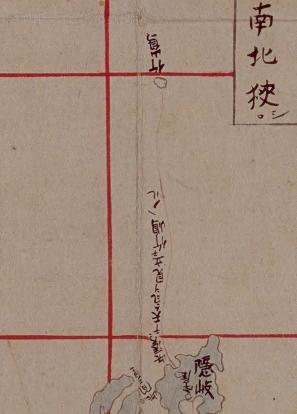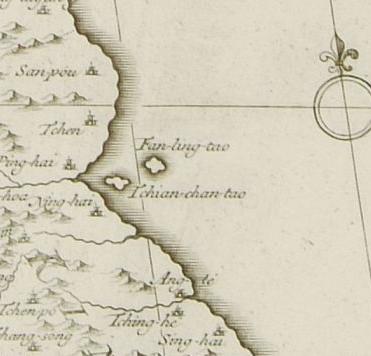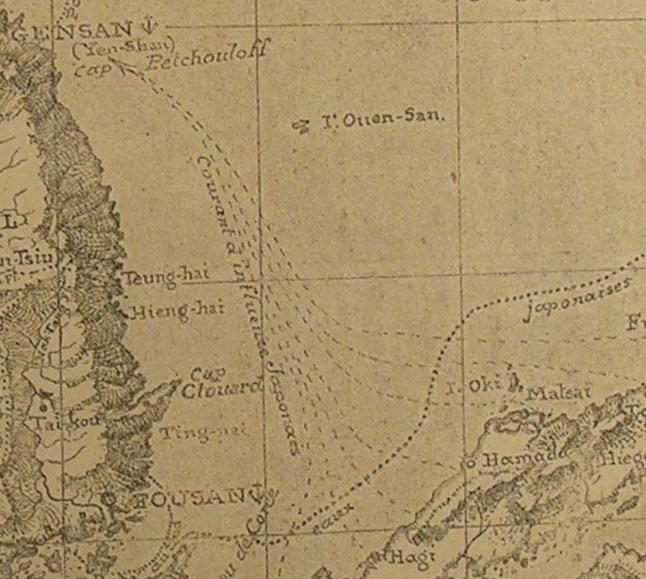 (Left : "The Field Chart of Japan (日本分野図)" from the site of National Archives of Japan )
(Left : "The Field Chart of Japan (日本分野図)" from the site of National Archives of Japan ) As we can see, "The Field Chart of Japan (日本分野図)" by Mori Kohan( 森幸安) clearly described Takeshima(Ulleungdo) as Japan's territory by drawing the sea route line from Oki to Ulleungdo. Nagakubo Sekisui is considered to have referred this map the most in the creating process of "Revised Complete Map of Japanese Lands and Roads", which Korean claim Nagakubo excluded Takeshima from Japan's territory, etc. In other word, against Korea's claim, this "The Field Chart of Japan (日本分野図)" by Mori Kohan( 森幸安) reinforces the Japan's claim that Nagakubo clearly recognized Takeshima and Matsushima as Japanese territory in 1779.
As we can see, "The Field Chart of Japan (日本分野図)" by Mori Kohan( 森幸安) clearly described Takeshima(Ulleungdo) as Japan's territory by drawing the sea route line from Oki to Ulleungdo. Nagakubo Sekisui is considered to have referred this map the most in the creating process of "Revised Complete Map of Japanese Lands and Roads", which Korean claim Nagakubo excluded Takeshima from Japan's territory, etc. In other word, against Korea's claim, this "The Field Chart of Japan (日本分野図)" by Mori Kohan( 森幸安) reinforces the Japan's claim that Nagakubo clearly recognized Takeshima and Matsushima as Japanese territory in 1779.(Right : Closeup of "The Field Chart of Japan (日本分野図)" from the site of National Archives of Japan )
Nagakubo Sekisui(長久保赤水) depicted Takeshima as Japan's territory on his map of Japan.
A group of island that are currently called Takeshima were once known as "Matsushima," and the island that is now known as Utsuryo (pronounced Ulleung in Korean) used to be known as "Takeshima" or "Isotakeshima." Although there has been a period of temporary confusion concerning the names of Takeshima and Utsuryo Island due to an error in the charting of Utsuryo Island by European explorers and others, it is obvious from a variety of written documents that Japan has long recognized the existence of "Takeshima" and "Matsushima." For example, on many maps, including "Kaisei Nippon Yochi Rotei Zenzu (Revised Complete Map of Japanese Lands and Roads(日本輿地路程全図): first published in 1779)" by Sekisui Nagakubo, which is the most prominent published cartographic projection of Japan, the locations of Utsuryo Island and Takeshima are accurately recorded at their current position between the Korean Peninsula and the Oki Islands. (MOFA, 2008)
 Korean claims that the "Onshu-shicho-goki(隠州視聴合記)" and "the Complete Map of Japanese Lands and Roads", both of which Japan used as the basis to prove that Takeshima (Dokdo) was Japanese territory, instead are the basis to prove that Dokdo is Korean territory. The interpretation of the sentence “Viewing Koryo is just the same as viewing Onshu (Oki island) from Unshu (Izumo) [見高麗猶雲州望隠州]” makes it clear, however, to which of Japan or Korea the place where one could view Koryo belonged. Nagakubo Sekisui made that notation next to Ulleungdo when quoting from the Onshu-shicho-goki because he believed that Ulleungdo was Japanese territory--he wasn’t reconfirming that Dokdo was Korean territory.
Korean claims that the "Onshu-shicho-goki(隠州視聴合記)" and "the Complete Map of Japanese Lands and Roads", both of which Japan used as the basis to prove that Takeshima (Dokdo) was Japanese territory, instead are the basis to prove that Dokdo is Korean territory. The interpretation of the sentence “Viewing Koryo is just the same as viewing Onshu (Oki island) from Unshu (Izumo) [見高麗猶雲州望隠州]” makes it clear, however, to which of Japan or Korea the place where one could view Koryo belonged. Nagakubo Sekisui made that notation next to Ulleungdo when quoting from the Onshu-shicho-goki because he believed that Ulleungdo was Japanese territory--he wasn’t reconfirming that Dokdo was Korean territory.
Indeed, Saito Hosen, the author of Onshu-shicho-goki, also wrote in the book the fact that the Oya family from Yonago of the Tottori domain frequently visited Ulleungdo. He had no doubt that Ulleungdo was Japanese territory. And when one of the Oya family’s ships drifted ashore in Korea in 1666, one year before the publication of Onshu-shicho-gouki, the Korean government graciously returned it. The Edo Shogunate grasped the meaning of that event and also recognized that Ulleungdo was Japanese territory. Even in 1695, when Edo Shogunate banned Ohya and Murakawa clan the voyage to Ulleungdo, both government didn't even hinted Usando in the process of negotiacion, not to mention of Matushima, today's Takeshima/Liancourt Rocks, which suggests that Joseon didn't even know the existence of the tiny island 92km far from Ulleungdo. Ulleungdo had been the easternmost of Joseon territory, and none of Korean historical documents suggest Ulleungdo nor Usanguk, the old name of coutry of Ulleungdo, includes Takeshima/Dokdo. As we have seen, there is no evidence that Koreans ever traveled to Liancourt Rocks (Dokdo/Takeshima) before Japanese fishing boats started taking them there in the early 1900s, and the islets do not appear on any of Korea's old maps by any name.
Other concrete evidences that Nagakubo Sekisui considered Takeshima(Ulleungdo) and Matsushima as Japanese territory, most likely, the country of Oki.
-
 The additional remark next to Ulleungdo, "見高麗猶雲州望隠州( From there(Ulleungdo) you can view Korea, it is just like you view Onshu (Oki island) from Unshu (east of Shimane prefecture, mainland of Japan)", on his map was cited from the " Onshu Shicho Goki (隠州視聴合記)" by Saito Hosen, which states Ulleungdo was the westmost of Japanese territory.
The additional remark next to Ulleungdo, "見高麗猶雲州望隠州( From there(Ulleungdo) you can view Korea, it is just like you view Onshu (Oki island) from Unshu (east of Shimane prefecture, mainland of Japan)", on his map was cited from the " Onshu Shicho Goki (隠州視聴合記)" by Saito Hosen, which states Ulleungdo was the westmost of Japanese territory. - He coloured both islands from the later edition as Japanese territory.
- In the first edition, not only two islands, but also other important Japanese islands like Gogohshima(御号島 : today's Okinoshima(沖ノ島), Kuchinoerabu(口永良部島)、Ezo(蝦夷地 : Hokkaido) were also uncoloured. It is obvious that those Japanese islands uncoloured were not considered to be outside of Japanese territory, but only described to be distant islands of Japan from the mainland.
- Nagakubo’s other map ("Map of Asia and Small Orient(亜細亜小東洋圖, 1835)") clearly shows Takeshima and Matsushima as Japanese territory.
- Nagakubo was in charge of compiling the geographical volume of the "Great Chronicles of Japan"(大日本史 or Dai-Nihonshi). The geographical documents were drafted by him. Under the article of 4 of district of Oki country, it says that "in addition, there are Matsushima(today's Takeshima/Liancourt Rocks) and Takeshima(Ulleundo) and those island belong to Oki.
 Mori Kohan (森 幸安 : 1701(14th year of Genroku) - ? )
Mori Kohan (森 幸安 : 1701(14th year of Genroku) - ? )Mori Kohan was born in Kyoto and studied the historical evidence for the map in the middle of Edo period. He collected or copied the maps of Japan and the world in Kyoto and Osaka from 1748 to 1763, counting almost 300 of them, and information related to the map was written down in detail on a margin by the Chinese writing . It is said that he combined those maps to produce "The Atlas of Japan (日本輿地図)". "The Field Chart of Japan (日本分野図)" of "The Atlas of Japan" described the parallel and the meridian for the first time as Japanese map and even latitude is recorded on the parallel line. Mori noted that he recorded the latitued to record the climate of each latitude (Japan is a warm coutny with the four seasons). Takeshima is also described as Japanese territory with sea route from Oki.
(Right : "The Map of Ogasawara islands (1752)" from "The Atlas of Japan" by Mori Kohan. It shows that Ogasawara Islands(Bonin Islands : 無人島) were well-recognized by Japanese as its territory way before American came around in 1800s.)
References :
Shimane Prefecture (Eng. Jap. & Kor.)
Japanese Ministry of Foreign Affairs (Eng.)
The 19th column “Seeking Truth Based Solely on Facts(実事求是)”
1696 - Ordinance Prohibiting Voyages to Takeshima (幕府 渡航禁制令)
1835 - "Map of Asia and Small Orient(亜細亜小東洋圖)" shows Takeshima/Dokdo as Japanese territory
1667 - Onshu Shicho Goki (隠州視聴合記)
1667 - "Onshu Shicho Goki(隠州視聴合記)" - The different translations
















